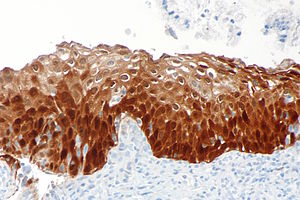Difference between revisions of "P16"
Jump to navigation
Jump to search

| Line 1: | Line 1: | ||
{{ Infobox immunostain | |||
| Name = {{PAGENAME}} | |||
| Image = High grade squamous intraepithelial lesion - 2 - p16 -- high mag.jpg | |||
| Width = | |||
| Caption = [[HSIL]] showing the characteristic p16 staining. (WC/Nephron) | |||
| Abbrev = | |||
| Synonyms = | |||
| Similar = [[HPV]] | |||
| Clones = | |||
| Use = | |||
| Subspecial = [[gynecologic pathology]], [[head and neck pathology]] | |||
| Pattern = | |||
| Positive = [[Cervical SCC]], [[HPV-associated head and neck SCC]], [[serous carcinoma of the endometrium]] | |||
| Negative = | |||
| Other = | |||
}} | |||
[[Image:Endocervical adenocarcinoma in situ - p16 --- high mag.jpg|thumb|right|250px|[[Endocervical AIS]] showing the characteristic p16 staining.]] | [[Image:Endocervical adenocarcinoma in situ - p16 --- high mag.jpg|thumb|right|250px|[[Endocervical AIS]] showing the characteristic p16 staining.]] | ||
'''p16''' is a commonly used [[immunostain]]. It can be considered a surrogate marker for [[HPV]] infection. | '''p16''' is a commonly used [[immunostain]]. It can be considered a surrogate marker for [[HPV]] infection. | ||
Revision as of 12:32, 6 June 2016
| P16 | |
|---|---|
| Immunostain in short | |
 HSIL showing the characteristic p16 staining. (WC/Nephron) | |
| Similar stains | HPV |
| Subspeciality | gynecologic pathology, head and neck pathology |
| Positive | Cervical SCC, HPV-associated head and neck SCC, serous carcinoma of the endometrium |

Endocervical AIS showing the characteristic p16 staining.
p16 is a commonly used immunostain. It can be considered a surrogate marker for HPV infection. p16, like most other "p" stains, is a nuclear stain.
Pattern
- Nuclear stain +/- cytoplasmic staining.
Use
- Squamous lesions of the uterine cervix - see HSIL.
- Head and neck squamous cell carcinoma, specifically human papillomavirus-associated head and neck squamous cell carcinoma.
Tumours
Positive
- Squamous cell carcinoma - esp. cervical SCC, anal SCC, penile SCC, HPV-associated head and neck SCC.
- High grade urothelial carcinoma ~86% of cases by PCR.[1]
- Serous carcinoma of the endometrium - should be strong.[2]
Negative
- Breast carcinoma.
- Prostate carcinoma.
- Lung squamous cell carcinoma.[3]
References
- ↑ Piaton, E.; Casalegno, JS.; Advenier, AS.; Decaussin-Petrucci, M.; Mege-Lechevallier, F.; Ruffion, A.; Mekki, Y. (Oct 2014). "p16(INK4a) overexpression is not linked to oncogenic human papillomaviruses in patients with high-grade urothelial cancer cells.". Cancer Cytopathol 122 (10): 760-9. doi:10.1002/cncy.21462. PMID 25069600.
- ↑ Chiesa-Vottero, AG.; Malpica, A.; Deavers, MT.; Broaddus, R.; Nuovo, GJ.; Silva, EG. (Jul 2007). "Immunohistochemical overexpression of p16 and p53 in uterine serous carcinoma and ovarian high-grade serous carcinoma.". Int J Gynecol Pathol 26 (3): 328-33. doi:10.1097/01.pgp.0000235065.31301.3e. PMID 17581420.
- ↑ Pereira, TC.; Share, SM.; Magalhães, AV.; Silverman, JF. (Jan 2011). "Can we tell the site of origin of metastatic squamous cell carcinoma? An immunohistochemical tissue microarray study of 194 cases.". Appl Immunohistochem Mol Morphol 19 (1): 10-4. doi:10.1097/PAI.0b013e3181ecaf1c. PMID 20823766.